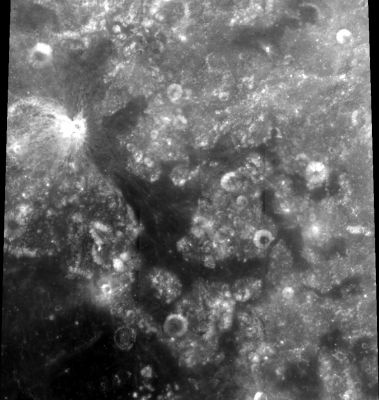Mare Anguis
Contents
Mare Anguis
|
Lat: 22.6°N, Long: 67.7°E, Diam: 150 km, Depth: km, Rükl: 27 |
Images
LPOD Photo Gallery Lunar Orbiter Images Apollo Images
Mare Anguis was captured on several oblique north-looking Fairchild camera frames made by Apollo 17, such as AS17-M-0914, in which Mare Anguis is noticeable between the expanse of Mare Crisium and the central part of the curved horizon.
Research Danny Caes
Maps
(LAC zone 44C2) LAC map Geologic map
Description
Description: Wikipedia
Additional Information
- Mare area of 8,150 km^2 according to measurements by Jim Whitford-Stark.
Nomenclature
- The Latin IAU name is officially translated as "Serpent Sea", but might possibly also have been meant as "Dragon Sea". - Jim Mosher
- Whitaker (p. 225) says the name Mare Anguis was given by Julius Franz, and according to astronomical historian Robert Garfinkle, although apparently not mentioned in the text it appears as a label on a map in Franz' Der Mond (1912).
- Mare Anguis was inserted as Catalog Number 43a in the original IAU nomenclature of Named Lunar Formations.
- Also according to Garfinkle, in Franz's 1918 Die Randlandschaften des Mondes (which includes a catalog of control points in the Moon's limb regions), Mare Anguis is not labeled, however Franz assigns fanciful dragon or sea serpent-themed nicknames to a number of points in and around it (Franz' enjoyment in seeing such imaginary patterns can be noticed in his description of the inverted image of Mare Nubium seen in his telescope as resembling the profile of a bearded oriental):
- Zungenspitze = tip of the tongue
- Kamm des Drachen = "comb" (as on a rooster) of the dragon/monster
- Auge = eye
- Schwanzende = tail-end
- These previously unnamed features (with the exception of "Kamm des Drachen" which they said corresponded to Neison's "Eimmart Delta") were re-named by Blagg and Müller and added to Named Lunar Formations. The following table gives their positions and new names as reported on pages 2 and 3 of NLF:
| Number |
Name |
Number |
Name |
||
| 1229 |
Zungenspitze |
43d |
Mare Anguis Xi |
+876 |
+330 |
| 1230 |
Kamm des Drachen |
38a |
Eimmart Delta |
+856 |
+351 |
| 1231 |
Auge |
43b |
Mare Anguis A |
+864 |
+358 |
| 1232 |
Schwanzende |
43c |
Mare Anguis T |
+821 |
+437 |
- Mare Anguis A is listed as a crater in NLF even though the position corresponds to an elevated area in the mare, and Franz describes it as "bright." Mare Anguis T is likewise listed as a crater although from the position given, Franz' intention is unclear. Blagg and Muller also give Franz' nicknames as "Drachenkamm" (instead of "Kamm des Drachen") and "Drachenauge" (instead of "Auge").
- The area around Mare Anguis was extensively renamed in the University of Arizona's System of Lunar Craters, which frowned on naming satellite features after mare: Mare Anguis A and the Greek-lettered peaks disappeared, and Mare Anguis T became Eimmart T (and the neighboring crater was newly named Eimmart G).
- When the satellite feature names were re-introduced into the IAU database in 2006, the SLCs Eimmart T' also disappeared (apparently having not been listed in NASA RP-1097).
- The following diagram uses blue plus-marks to show the locations of Franz' fancifully-named control points as listed in NLF, and yellow dots to indicate the current IAU-named satellites of Eimmart:
- The positions are plotted on Lunar Orbiter and Clementine mosaics adjusted to zero libration using modern control points. Alhazen Alpha is the name (attributed to Beer and Mädler) of a prominent peak listed in NLF (where it is Catalog Number 19). The name disappeared, intentionally or not, in the System of Lunar Craters charts. Note that the crater named Eimmart K in SLC might seem a logical candidate for the serpent's "eye", but it does not correspond to the "Auge"/Mare Anguis A location listed in NLF.
- There's a typographical error on Philip's Moon Map; New Edition by John Murray and Peter Grego (2003), because the name Mare Anguis was printed on it as Mare Angius.- DannyCaes Jun 23, 2012
LPOD Articles
Bibliography

